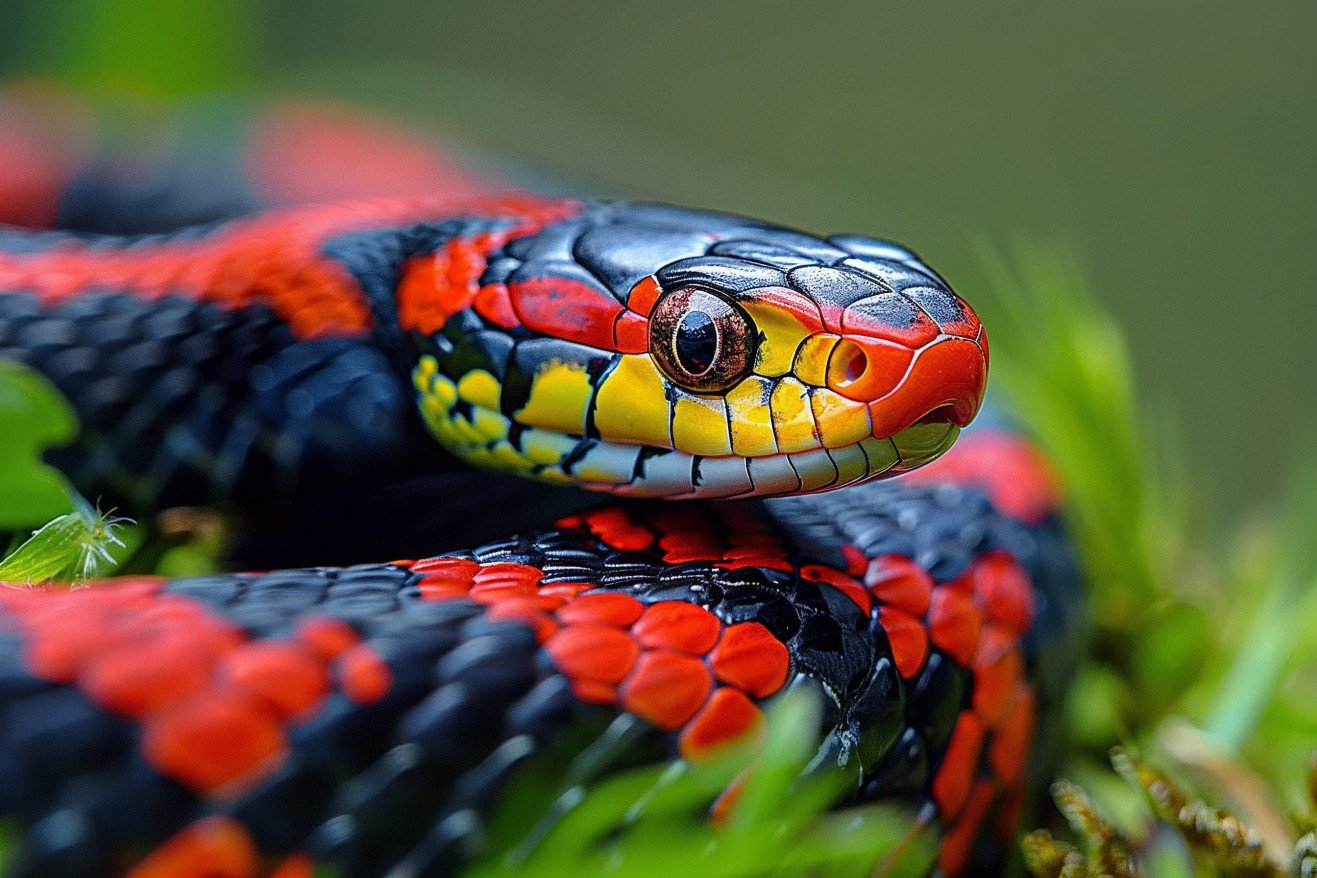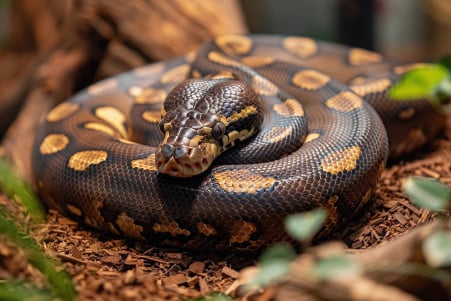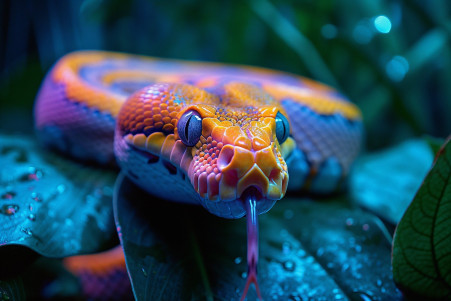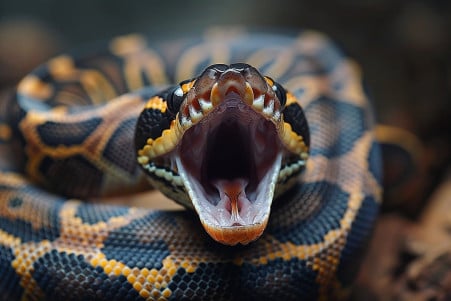Can Snakes Blink? A Look at Snake Vision and Evolution
5 April 2024 • Updated 4 April 2024

If you've ever asked yourself, "Can snakes blink?" you're not alone. Snakes don't have eyelids like humans, and so they can't blink. Instead, their eyes are covered by a clear, protective scale called a spectacle or brille that covers the eye and is permanently attached, coming off only when the snake sheds its skin. This scale allows snakes to see while keeping their eyes safe.
We'll take a deep dive into the anatomical and biological studies of snake vision, including how the evolution of their eyes has led to their unique eye structures and how this has impacted their hunting and survival. From the way pit vipers use their ability to detect heat to how snakes' vision has impacted their tendency to be diurnal or nocturnal, this investigation will shed light on the incredible ways these reptiles have adapted.
Can snakes blink?
The Evolution of Snake Vision and Eye Adaptations
Snakes have undergone remarkable evolutionary adaptations in their visual systems, enabling them to succeed in a wide range of habitats and ecological niches. At the core of these adaptations is the diversity of visual pigments in their retinas. As reported in a press release from the Natural History Museum, most snakes have three visual pigments, two of which are in cone cells, enabling them to see two colors, which is called dichromacy.
However, the press release also noted that most snakes studied were sensitive to ultraviolet (UV) light, which helps improve their ability to see in low light. Nocturnal snakes have evolved lenses that are transparent to UV light, while diurnal (day-active) species like the golden tree snake and vine snake have lenses that are opaque to UV light, enabling them to better see in bright daylight by blocking UV light from reaching their retinas.
Another example of this diversity is the variation in spectacle thickness between different species of snakes. A paper in BMC Veterinary Research reported that fossorial (burrowing) and aquatic snakes have much thicker spectacles than arboreal and terrestrial snakes, which provides more protection for their eyes. This difference in spectacle thickness suggests that the spectacle has evolved to have other functions besides protecting the eye, including potentially influencing vision and accommodation.
These evolutionary adaptations demonstrate the incredible diversity of snake vision and the amazing ways that snakes have adapted to their environments.
Sensory Adaptations: How Snakes Sense Their World
Snakes use a variety of senses to move through their environment and find food. For example, many snakes, including rattlesnakes and pythons, have pit organs that are sensitive to heat and allow them to detect infrared radiation from warm-blooded animals. As Dr. Pradeep Sharma explains in an article, these pit organs are like thermal "eyes" that enable snakes to "see" the heat of their prey even in total darkness.
In addition to their heat-sensing pit organs, snakes have a keen sense of smell. They use their forked tongues to pick up chemical signals in the air, which they then deposit on the Jacobson's organ in their mouth to determine if an animal is a potential food source, according to the Smithsonian article. While snakes have poor hearing and color vision compared to humans, some snakes, including the golden tree snake and vine snake, have good eyesight and stereoscopic vision, according to research at the Natural History Museum.
These sensory adaptations help snakes hunt in a variety of environments, from total darkness to dense forests. As we'll see in the next section, shedding is another important adaptation that helps snakes maintain their vision and eye health.
The Shedding Process: Renewing the Spectacle and Skin
Snakes shed their skin, including the spectacle that covers their eyes, in a process known as ecdysis. According to Britannica, the ecdysis process includes several phases, including the skin turning dull, the eyes turning opaque or "in-blue," and fluid accumulating between the layers of skin.
Proper shedding of the spectacle is important for maintaining clear vision and avoiding a condition known as retained eye caps. As noted by The Spruce Pets, retained eye caps happen when the scales covering a snake's eyes don't come off during shedding. This can cause vision problems and even lead to infections if it's not addressed.
To make sure that retained eye caps don't happen, it's important to make sure that the humidity in the snake's enclosure is at the right level, as dehydration can lead to shedding issues. According to The Tye-Dyed Iguana, extra moisture can be added to the skin during the shedding process, and some snake owners with a lot of experience may even use tape to gently remove retained eye caps. Making sure that the snake isn't disturbed during this time is another way to make sure that the shedding process goes smoothly.
Snakes' Sleep Patterns and Eye Behavior
Snakes don't sleep in the traditional sense, and their lack of eyelids means they can't close their eyes. Instead, snakes go into a state of reduced activity and responsiveness with their eyes open. According to research, snakes can close the retinas in their eyes when they are sleeping, even though their eyes remain open.
The spectacle or brille, which is a transparent scale that covers a snake's eyes, helps protect their eyes while they're in this state. However, snakes may also exhibit other behaviors to protect their eyes, like lowering their head to the ground and pressing their face into the substrate, or using their tongue to lick and lubricate their eyes, as noted in research.
Despite the popular myth, snakes do produce tears to moisten and lubricate their eyes. Research shows that the fluid between the retinas and the spectacles is produced by tear glands, although it can't spill out and run down the snake's face like it does in mammals. Snakes can also close their retinas while they're awake to rest their eyes without fully closing them.
These sleep patterns and eye behaviors are just some of the many adaptations that help snakes overcome the challenges of not being able to blink or fully close their eyes.
Conclusion: The Amazing Adaptations of Snakes
Snakes have evolved a number of adaptations that enable them to survive and thrive in their environments despite not having the ability to blink or close their eyes. In combination with other sensory adaptations, such as heat-sensing pits and a highly developed sense of smell, the spectacle allows snakes to move and hunt successfully.
The shedding process and the renewal of the spectacle are essential for maintaining clear vision and eye health. Understanding these adaptations provides a window into the amazing diversity and adaptability of the natural world. Future studies of snake vision and sensory adaptations may also have implications and applications in a variety of areas.


